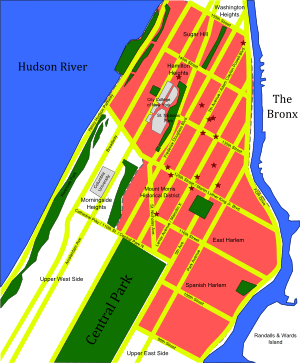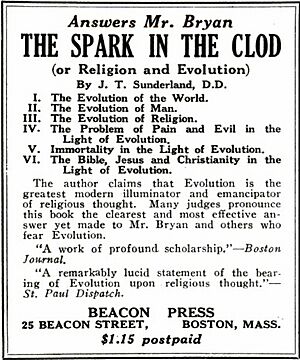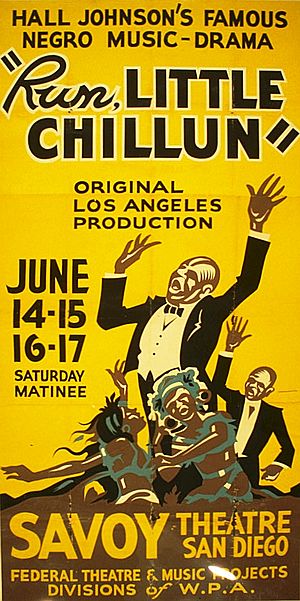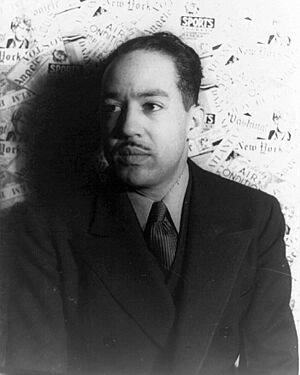Harlem Renaissance facts for kids
| Part of the Roaring Twenties | |
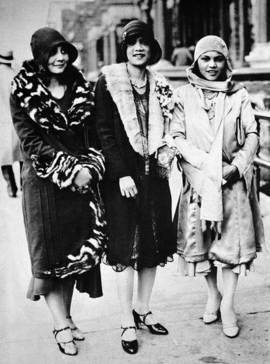
Three African-American women in Harlem during the Harlem Renaissance in 1925
|
|
| Date | 1918–mid-1930s |
|---|---|
| Location | Harlem, New York City, United States and influences from Paris, France |
| Also known as | New Negro Movement |
| Participants | Various artists and social critics |
| Outcome | Mainstream recognition of cultural developments and idea of New Negro |
The Harlem Renaissance was an exciting time for African-American culture. It was a period in the 1920s and 1930s when Black artists, writers, musicians, and thinkers created amazing new works. This movement was centered in Harlem, a neighborhood in New York City.
During this time, many African Americans moved from the Southern United States to Northern cities like Harlem. They were looking for better opportunities and to escape unfair rules and discrimination. This big move was called the Great Migration.
The Harlem Renaissance was also known as the "New Negro Movement". It celebrated African-American identity and talent. Many important artists and writers became famous during these years. Their work helped change how people saw African Americans in the United States and around the world.
Contents
Why the Harlem Renaissance Happened
For a long time, most African Americans lived in the Southern United States. Many had been enslaved until the end of the American Civil War. After the war, during the Reconstruction Era, African Americans worked hard for equal rights. They wanted to participate in government and have economic freedom.
However, after Reconstruction, new challenges arose. Unfair laws, known as Jim Crow laws, were put in place in the South. These laws created segregation and limited the rights of African Americans. Many were stopped from voting and faced harsh discrimination.
Life in the South became very difficult for African Americans. They faced unfair treatment and violence. Many were forced into labor systems that were like slavery. A tiny beetle called the boll weevil also destroyed cotton crops, making farming even harder. Because of these problems, many African Americans decided to move North.
This movement was called the Great Migration. People moved to cities in the Northeast and Midwest, like Harlem. They hoped for better jobs, safer lives, and more respect. Some also came from the Caribbean looking for new opportunities. Harlem became a central place where many of these people gathered.
Harlem Becomes a Cultural Hub
In the early 1900s, Harlem became a popular place for African Americans. People came from the South looking for work and a new life. Educated individuals also moved there, making it a center for culture.
Harlem had once been a fancy neighborhood for wealthy white families. But by the early 1900s, many of these families had moved away. This opened up homes and spaces for African Americans.
In 1910, African-American real estate agents and church groups bought a large area in Harlem. This helped more Black families move into the neighborhood. During World War I, even more African Americans came North. The war created many factory jobs, and the Great Migration brought hundreds of thousands to cities like New York.
Even in the North, African Americans still faced unfair treatment. After World War I, Black soldiers returned home after fighting bravely. But they often did not receive the respect they deserved. There were also conflicts over jobs and housing in many cities.
New Voices in Theater and Poetry
The Harlem Renaissance began to gain attention in the late 1910s. In 1917, new plays were shown that featured African-American actors. These plays, like Granny Maumee, showed Black characters with real emotions. They moved away from old, unfair stereotypes often seen in shows like blackface minstrel acts.
In 1919, poet Claude McKay published a powerful poem called "If We Must Die". It spoke about standing up against unfairness. This poem resonated with many African Americans who faced discrimination. By the end of World War I, writers like McKay and James Weldon Johnson were sharing the true experiences of Black life in America.
The Harlem Renaissance grew because of many changes. The Great Migration brought many talented people to Northern cities. World War I also created new job opportunities. All these factors helped create a vibrant new culture. However, the Great Depression later caused the movement to slow down.
Powerful Voices in Literature
Literature was a huge part of the Harlem Renaissance. Writers like Hubert Harrison started newspapers that shared both political ideas and art. He even had sections for "Poetry for the People."
The movement gave African-American writers a chance to share their stories. As Langston Hughes said, it gave them "the courage to express our individual dark-skinned selves without fear or shame." An important book called The New Negro by Alain Locke showcased many Black writers. It included famous names like Zora Neale Hurston and Langston Hughes.
Poets often mixed African-American culture into their work. This led to the rise of jazz poetry, which used the rhythms of jazz music. Langston Hughes's poem "The Weary Blues" is a great example. Through their books and poems, these authors helped define African-American identity and built a sense of community.
Faith and Spirituality
Religion was an important part of life during the Harlem Renaissance. Many writers and thinkers explored how Christianity shaped African-American experiences. For example, Langston Hughes wrote a poem called "Madam and the Minister" that showed feelings about religion at the time.
Magazines like The Crisis discussed important religious topics. They wrote about challenges faced by African-American priests in the Catholic Church. These articles highlighted unfair rules that kept Black individuals from leadership roles.
People practiced many different forms of faith. Even though some religious groups had unfair attitudes, many African Americans worked for more welcoming beliefs. Some also practiced spiritual traditions from their African heritage. These included Islam, which came to Harlem through groups like the Moorish Science Temple of America. Different forms of Judaism were also practiced.
The Sounds of Jazz and Blues
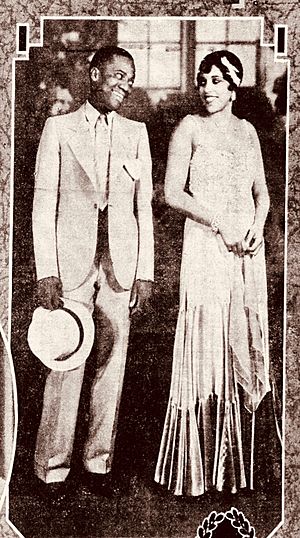
Music was a huge part of the Harlem Renaissance. A new piano style called Harlem Stride became popular. It helped bring jazz music to more people. Before, jazz was often played with brass instruments and linked to the South. The piano made it more accessible to everyone.
Many talented jazz musicians and composers emerged. These included Eubie Blake, Jelly Roll Morton, James P. Johnson, and bandleaders like Duke Ellington and Louis Armstrong. They were very skilled and inspired many future artists.
Duke Ellington became especially famous during this time. He was a gifted composer and bandleader. He stayed focused on his music, even as his popularity grew.
African-American music also started to influence white artists. Composers like William Grant Still and Florence Price used Black poems in their songs. They added rhythms and melodies from blues, spirituals, and jazz into their classical pieces. This helped bridge the gap between different musical worlds. Roland Hayes was one of the first African-American concert artists to gain international fame.
Musical Theater on Broadway
Musicals created by African Americans also became very popular. The show Shuffle Along, with music by Eubie Blake and Noble Sissle, opened in 1921. It was a big hit with all audiences and brought jazz to Broadway.
Shuffle Along showed that both Black and white audiences loved seeing African Americans perform on Broadway. It ran for many shows and toured the country. Langston Hughes later wrote that the Harlem Renaissance truly began with Shuffle Along. Another successful musical drama was Run, Little Chillun.
Fashion and Style
Fashion in Harlem during this era was vibrant and expressive. Young women wore loose-fitting dresses, short skirts, and cloche hats. They accessorized with long pearl necklaces and feather boas. Clothes were designed for elegance and the lively dance styles of the 1920s.
Men's fashion also stood out. They wore loose suits that later inspired the "Zoot" style. These suits had wide-legged trousers and long coats with padded shoulders. Men also wore wide-brimmed hats and colorful socks. Some even wore leopard-skin coats to show respect for their African heritage.
The famous dancer Josephine Baker was a major fashion trendsetter. Her stage costumes were copied by many. She also helped popularize "art deco" fashion with her unique performances.
Capturing Moments: Photography
James Van Der Zee was a very important photographer during the Harlem Renaissance. His pictures helped show and shape the cultural life of Harlem. He documented the achievements of artists and leaders. His work challenged stereotypes and brought pride to African Americans.
Van Der Zee's studio was more than just a place to take photos. It was a social center where people gathered and connected. He photographed many famous figures, including Marcus Garvey, Countee Cullen, Josephine Baker, W. E. B. Du Bois, Langston Hughes, and Madam C. J. Walker.
His photographs are now seen as vital records of African-American life in the early 20th century. They visually tell the story of the Harlem Renaissance.
Art on Canvas: Painting
Aaron Douglas is often called the "Father of African-American Art." Born in 1899, he was one of the most influential painters of the Harlem Renaissance. His paintings used colors, shapes, and lines to connect the past, present, and future of African-American history. Douglas found inspiration in ancient Egyptian and Native American art.
Shaping Forms: Sculpting
Augusta Savage, born in 1892, was a sculptor, advocate, and teacher. She focused on creating art that showed everyday Black people. In 1932, Savage started the Savage Studio of Arts and Crafts. It offered free art classes to young people and adults.
Savage was a leader in the Harlem community. She encouraged artists to get paid fairly for their work, which led to the creation of the Harlem Artist Guild. She was also chosen to create a special exhibit for the 1939 World's Fair in New York. Her sculpture, Lift Every Voice and Sing, became one of the fair's most popular pieces.
Main Ideas and Themes
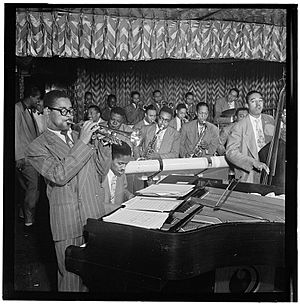
A key part of the Harlem Renaissance was a strong sense of racial pride. This was seen in the idea of the "New Negro." This idea suggested that through art, literature, and intellect, African Americans could challenge unfair treatment and stereotypes. They aimed to promote progress and equality.
The art from the Harlem Renaissance didn't have just one style. It included many different cultural elements. These ranged from traditional music to blues and jazz, and from traditional writing to new forms like modernism and jazz poetry. This variety sometimes led to disagreements among Black thinkers about how Black life should be shown.
Common themes in the art included:
- The impact of slavery and African-American folk traditions on identity.
- The effects of unfair systems and discrimination.
- The challenges of creating art for white audiences.
- How to show modern Black life in Northern cities.
The Harlem Renaissance was mainly driven by African Americans. It had support from Black patrons and Black-owned businesses. However, it also received help from white Americans, like Carl Van Vechten. This support often helped Black artists get their work published outside the Black community.
The Harlem Renaissance helped set the stage for the Civil Rights movement that came after World War II. Many Black artists who became famous later were inspired by this movement.
The Renaissance was more than just art and literature. It also brought about new ideas about racial identity and pride. Marcus Garvey led the Back to Africa movement, which focused on Black nationalism. At the same time, W. E. B. Du Bois introduced the idea of the "talented tenth." He believed that the most educated and talented Black individuals would lead the race forward.
Lasting Impact
The Harlem Renaissance was very successful in bringing the Black experience into the story of American culture. It wasn't just about an explosion of art. It also changed how America and the world viewed African Americans.
The move of Black people from the South to the North changed their image. They went from being seen as rural farmers to sophisticated city dwellers. This new identity led to greater awareness and pride. African Americans became important figures on the world stage.
The progress made during this time became a source of inspiration. It gave the African-American community a strong sense of self-belief. This helped lay the groundwork for the Civil Rights struggles of the 1950s and 1960s.
Harlem's lively city environment allowed African Americans from all backgrounds to celebrate their diverse culture. This encouraged a new appreciation for their folk roots and traditions. By sharing these cultural experiences, a strong, united racial identity grew.
Works from the Harlem Renaissance
- Blackbirds of 1928
- The New Negro: The Life of Alain Locke
- Shuffle Along, musical
- Untitled (The Birth), painting
- Voodoo (opera)
- When Washington Was in Vogue
- The Negro in Art
- Taboo (1922 play)
- There'll Be Some Changes Made
See also
- Black Arts Movement, 1960s and 1970s
- Black Renaissance in D.C.
- Chicago Black Renaissance
- List of female entertainers of the Harlem Renaissance
- List of figures from the Harlem Renaissance
- New Negro
- William E. Harmon Foundation award
- Black and tan clubs, nightclubs featuring black performers
- Cotton Club, nightclub
General:
- Roaring Twenties
- African-American art
- African-American culture
- African-American literature
- List of African-American visual artists
See also
 In Spanish: Renacimiento de Harlem para niños
In Spanish: Renacimiento de Harlem para niños


